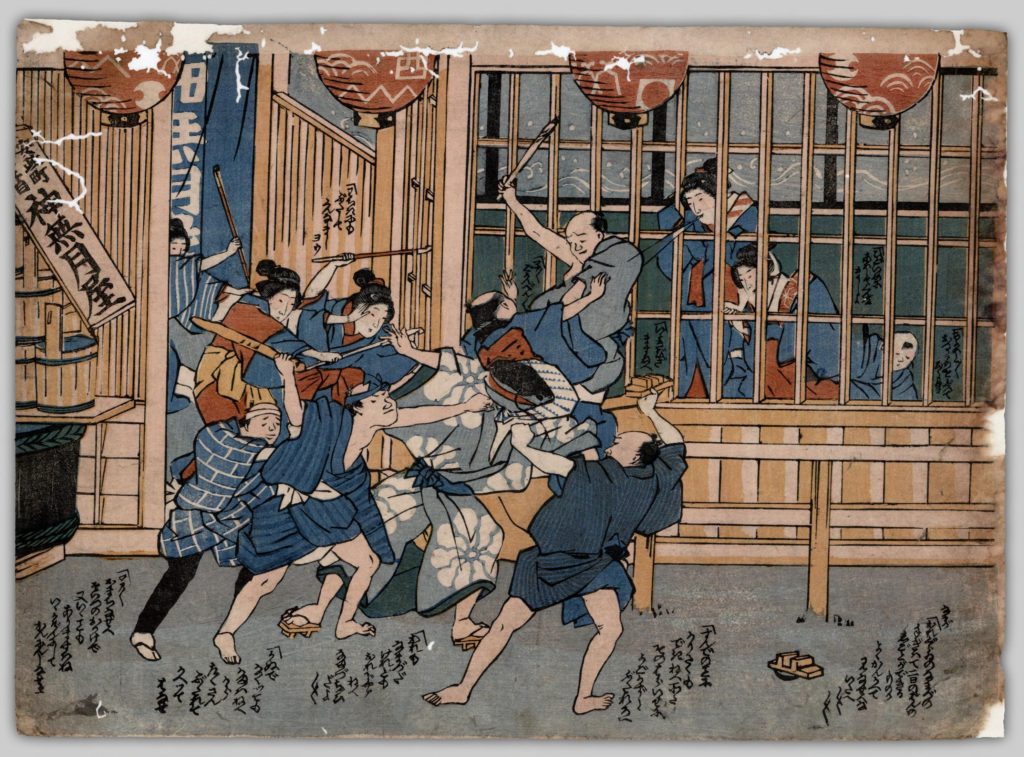Main Body
The Ansei Edo Earthquake and Catfish Prints
Gregory Smits | Pennsylvania State University
The Ansei Edo earthquake (Ansei Edo jishin 安政江戸地震) shook the de facto capital of Tokugawa Japan around 10:00 PM on November 11, 1855. However, the people of the time used a lunar calendar. So in their view, the earthquake struck on the second day of the tenth month. This timing was significant because a widely-known aspect of popular religion held that the major deities all gathered in Izumo (in western Japan) for a meeting during the tenth month, leaving behind lesser deities to fill in.
Estimates of the magnitude (M) of this earthquake are 6.9-7.0, and it did not produce a tsunami. Damage was severe in some areas and light in others, and the casualty rates varied similarly. The main determinate of the severity of ground motion was the nature of the soil base. Places that had once been swamps or other bodies of water but had been recently filled in collapsed dramatically, destroying structures and causing many casualties. For the most part, these severely shaken areas were the residences of elites or were associated with elites. Especially significant was the destruction in “Daimyo Lane” (damyō kōji 大名小路), the location of major fudai daimyo mansions and several major bakufu organs of government just below Edo castle. In 1600, this area had been Hibiya Inlet, part of the sea, before being filled in to create prime real estate. Also hard hit was the Yoshiwara pleasure quarters, a famous playground for the wealthy. Recently-built offshore artillery batteries (daiba 台場), an obvious symbol of shogunal power, all collapsed or were severely damaged.
Deaths for civilian and military personnel totaled 8,000-10,000, and they were concentrated in the severely damaged areas. Outside of these areas, including most commoner neighborhoods, casualties and damage were light. This uneven pattern of destruction is one reason that so many of the earthquake prints from this event seem playful or irreverent in tone. Popular culture in Edo already had this tendency, and for many of Edo’s ordinary denizens, the earthquake was a source of potential windfall profits. This potential for profit was especially apparent among skilled workers in the construction trades such as carpenters, roofers, and plasterers, and among merchants who dealt in supplies needed for rebuilding. For example, November 1855 was a good time to be a lumber wholesaler in Edo. Even many unskilled laborers, however, were able to find work at higher wages than usual, and government relief was fast and generous in this earthquake.
Because of the near total destruction of the Yoshiwara area, the bakufu authorized the opening of numerous temporary brothels around Edo. Many earthquake prints used these places as their setting and often depicted newly-rich construction workers spending money there. Overall prints from the Ansei Edo earthquake tended to interpret the significance of the event as a cosmically ordained shakeup of society such that money flowed from the coffers of the rich (daimyo and wealthy merchants) into the hands of hardworking laborers. The usual term for this redistribution of wealth in the context of the Ansei Edo earthquake was yonaoshi 世直し, literally “rectification of society.” This term might have other meanings, for example redress of peasant grievances, in other late Tokugawa era contexts.
Many earthquake prints feature some form of a catfish (namazu 鯰) and therefore the genre is typically called catfish prints (namazue 鯰絵), even though some individual prints lack a catfish. Note that “Namazu” is not really a proper noun, even though it appears that way in some of the print descriptions. Its use as a proper noun in these descriptions refers to the folk belief that a large stone, the kanameishi 要石 at the Kashima Shrine 鹿島神宮 to the northeast of Edo, pins down a giant subterranean catfish. The Kashima deity resides at the shrine and pushes down on the kanameishi to ensure that the catfish cannot move. During the tenth month, however, because he was absent for the meeting of deities at Izumo, the catfish shook off the foundation stone, moved around, and caused the earthquake.
Many catfish prints reply in this basic folk image of the catfish pinned down by the kanameishi. Catfish functioned as a visually striking and usefully malleable symbol of earthquakes in general, and of the Ansei Edo earthquake in particular. Even in today’s Japan, earthquake warning signs in public places sometimes feature an image of a catfish.
It is important to note however, that most denizens of Edo understood this scenario as metaphoric. Earthquakes were understood as the result of an imbalance in yin (cool) and yang (hot) energy. When too much yang energy built up within the earth and sought to escape upward, an earthquake could result, especially in the case of clay soil. Catfish were a widely-recognized symbol of earthquakes, but it is unlikely that many, if any, residents of Edo in 1855 thought that catfish, large or small, actually caused earthquakes.
By 1855, residents of Edo had long been accustomed to broadside prints that commented on the state of society and recent events. There was a censorship system in place, but by coding messages in one or more layers of symbolism and by making use of plays on words, it was possible to produce prints whose messages would have been censored if stated baldly. In other words, the people of Edo were well practiced in reading coded messages, and it is this phenomenon that makes the catfish prints so interesting. In the guise of reporting on the earthquake, they serve as a window through which to glimpse Edo society.
Contrast the catfish prints with disaster prints 7, 9, and 10 in the UBC Open Collections [Figures 1.1, 1.2, and 1.3]. These three prints are attempts realistically to depict the horrors of the 1896 Meiji Sanriku tsunami. This tsunami devastated the Sanriku coast (approximately the same area devastated in 2011), killing over 20,000. These prints succeed in conveying some sense of the disaster, but there is little to analyze about them beyond certain technical features. The 1855 catfish prints, by contrast, are rich in symbolic social commentary, often in multiple layers.
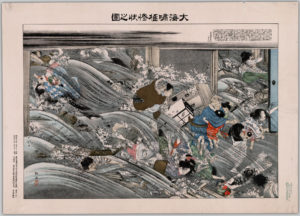
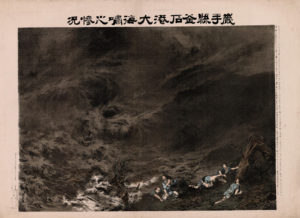
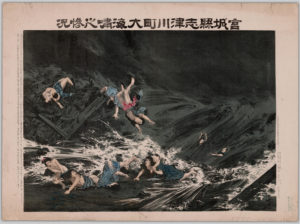
In the paragraphs below, I discuss the majority of the catfish prints in the UBC Open Collections. For ease of identification, prints are listed by the number in the collection, and titled using the bracketed description from the web site, even if that description contains errors.
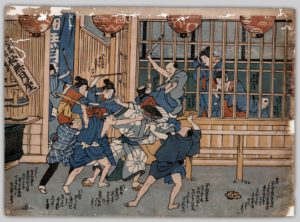
Figure 2 reveals important points about the social dynamics of the 1855 Ansei Edo earthquake. The basic image is that of an anthropomorphic catfish, in disguise, visiting or passing by a brothel, while the courtesans and customers attack him. The superficial point is that the catfish caused the earthquake and thus is worthy of animosity or retribution for the damage he has inflicted on society.
The name of the brothel is Kannazukiya 神無月屋, a reference to the tenth lunar month, known as Kannazuki or Kannaizuki (month of no deities). During this month, the major deities around Japan travel to Izumo for a conference, leaving lesser deities temporarily in charge. In the Edo area, Kashima left the less competent Ebisu in charge of protecting the city against earthquakes, thus making possible the earthquake that struck on the night of the second day of that month. The reference to Kannazuki might also function to suggest that this catfish is not the proper object of blame.
The catfish himself protests his beating, starting with the statement “Is it possible that a catfish like me has the power to cause the event of the night of the second day?” The catfish goes on to remind the crowd that the earthquake resulted in this karitaku (temporary brothel established in the wake of the earthquake) and the money circulating through it.
Notice the man at the bottom left with black trousers and a brick-like pattern on his blue jacket. He is a skilled construction worker, someone who stands to profit greatly from the rebuilding. Instead of assaulting the catfish, he seeks to restrain the crowd, saying “Thanks to that guy, some good things have happened. Don’t treat him so roughly!”
This print is a good example of the general tendency to interpret the Ansei Edo earthquake as an instance of yo-naoshi 世直し. The meaning of this term can differ from one context to another. In connection with this earthquake, it indicated a transfer of wealth from elite merchants and from daimyo into the hands of laborers, especially skilled construction workers. Many prints depicted these workers as spending their windfall profits in brothels.
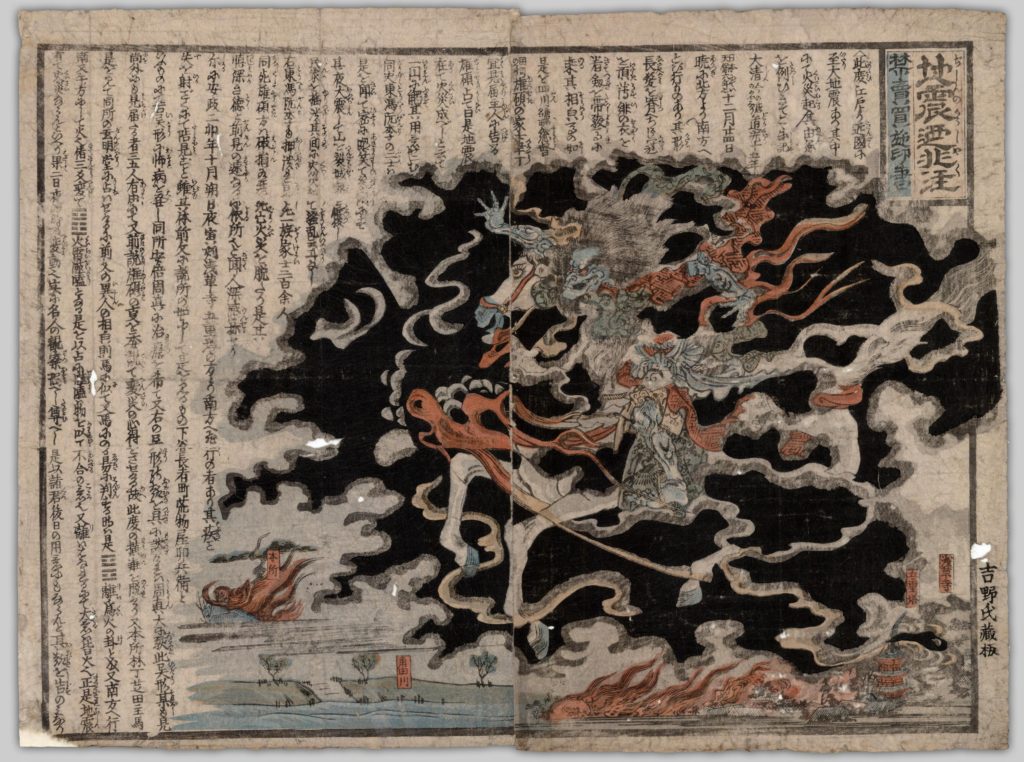
Despite the description, the print in Figure 3 is from 1855. The reason for the 1835 date is that the text mentions a Chinese earthquake from that year as an example of the phenomenon of a flash of light shooting up into the sky and traveling north to south in connection with an earthquake. It goes on to explain that in the Ansei Edo earthquake, a ray of light shot from the vicinity of the pagoda at Sensōji 浅草寺, traveling in a southward direction. The text provides a detailed explanation of this phenomenon, relying on the Classic of Changes (C. Yijjing; J. Ekikyō 易経). The visual image is an imaginary close-up depiction of a “shining object” (hikarimono 光物) associated with earthquakes.
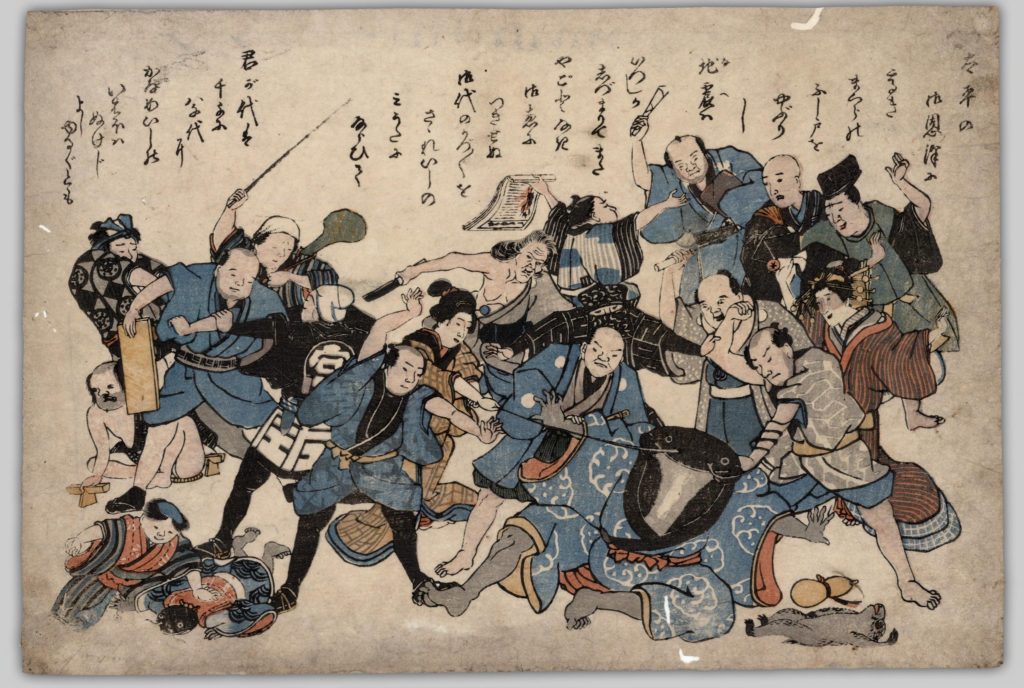
The catfish prints of 1855 often depicted society as divided into economic winners and losers vis-à-vis the earthquake. Here in Figure 4, wealthy merchants, Yoshiwara courtesans, Shinto and Buddhist priests, among others, attack the earthquake catfish. A construction worker and a roof tile seller (in black) are trying to restrain the crowd and save their friend the catfish.
This print also indulges in parody. At the bottom right is a monkey and a gourd, which is iconography from a different genre of popular prints, Ōtsue 大津絵. In that genre, a monkey uses a gourd to suppress a catfish. Here, the monkey has drank the liquor in the gourd and is passed out on the ground drunk. The text includes a parody of the song Kimigayo 君が代.
Located on swampy ground, the Yoshiwara red light district went up in flames as a result of the earthquake, with great loss of life. Soon thereafter, the bakufu authorized the establishment of numerous temporary brothels throughout Edo. The earthquake thus devastated a well-known playground for the wealthy, transforming it into local establishments patronized mainly by the newly-rich construction workers—at least according to popular depictions at the time.
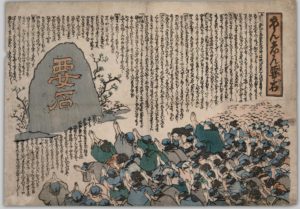
Kanameishi 要石 is sometimes translated as Foundation Stone. There are several kanameishi in shrines around Japan, but the one in the Kashima Shrine is most famous and appears in the 1855 prints, as in Figure 5.
The stone firmly planted in place, as in this print, is a symbol of clam and stability. The stone ajar, pushed over, or in the air (in some other prints) is a sign that the forces of disorder temporarily reign supreme. This print appears to be a retrospective on the recent earthquake. The text includes the perspectives of nine different groups: the elderly, carpenters, young courtesans, pottery merchants, geisha, Yoshiwara employees, a courageous person (who prays that there not be another earthquake), physicians, and “logical people” (rikutsumono), who are aware that praying to a stone is strange (fushigi).
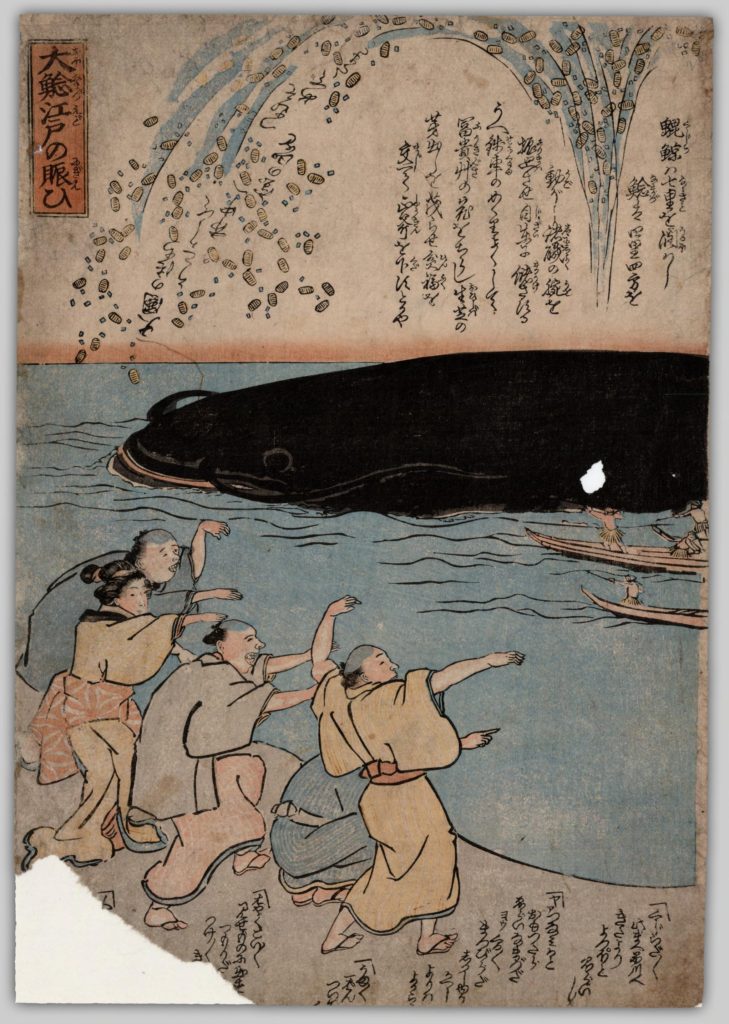
The carpenter wants finally to be able to finish his vastly increased workload, the young courtesan hopes to be able to watch a play in the future, and the overworked physician wants his overly large number of patients to heal quickly. In general, there is a widespread desire to return to the ordinary rhythms of life.
This complex print in Figure 6 depicts people seeking the prosperity that became apparent in the wake of the 1855 Ansei Edo earthquake. Notice several points. First, catfish do not have blowholes. Second the blowhole of whales is located atop their heads, not in the middle of their bodies.
Next, notice the text. To read easily the text intermingled with the gold coins apparently spewing from this large black sea creature requires turning the print upside down. Doing so causes the stream of water to look like a mountain. The upside-down text amidst the gold coins is 大国のつち、うごかして、市中へ、宝の山を、つむそ、めでたき. Its basic meaning is “The soil of the great country moves, piling up a mountain of treasure in the midst of the city. Auspicious.” The first phrase, daikoku no tsuchi is the same pronunciation as 大黒の槌, the magic mallet of the deity Daikoku, whose name literally means “big black.” Moreover, Daikoku and his coin-spewing mallet appear in other catfish prints, as we will see. In other words, there are multiple ways to view and interpret this print.
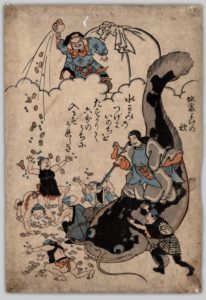
And there is yet another “big black” in it, the “black ships” that had recently visited Edo (1853 and 1854). “Black ship” was a common term at the time for steamships, and popular prints often depicted them as looking like giant sea monsters. Several prints and other earthquake commentary link the 1855 earthquake with Matthew Perry’s naval and diplomatic expeditions of 1853 and 1854, and other events of this tumultuous historical era. Notice that the coins are flowing from the place where the smokestack of a steamship would be located. This big black whale-catfish-steamship hybrid, although ominous in appearance, is potentially a source of great wealth. That is why the people in the foreground are beckoning it to come closer. The name of the print is Ō-Edo no furui (The shaking of greater Edo), which resonates with all the possible symbolism in the print.
It may seem odd to regard a major earthquake and the visit of Matthew Perry’s fleet as beneficial events. However, casualties in the earthquake were light overall, and they were concentrated in several elite neighborhoods. From the standpoint of ordinary denizens of Edo, the earthquake, while terrifying, was a source of windfall profit both in the form of generous government relief and in higher wages even for unskilled laborers during the rebuilding. Similarly, although Perry’s visit was jarring for the government, it tended to be fascinating for ordinary people. Moreover, there were many in Edo who thought that increased trade with new countries, via their city, could be a source of wealth, as it had been for Nagasaki.
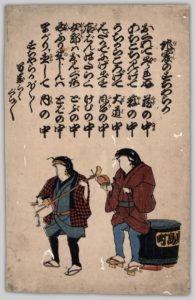
This description is somewhat peculiar, but like most catfish prints, Figure 7 contains multiple messages and symbols. We could call this print transitional. Prints in the immediate wake of the earthquake tended to feature a large, menacing catfish, with the Kashima deity gone (off to his meeting at Izumo) or rushing back to Edo to try to restore order. Moreover, the kanameishi is typically missing or dislodged in early prints, and if depicted, it tends to be very small. Later prints emphasize windfall profits for members of the construction trades and typically feature anthropomorphic catfish similar in size to humans.
In this print Kashima is in the process of bringing the violent giant catfish back under control. An old association of Kashima was with swords, and in this and other prints, Kashima’s sword substitutes for the kanameishi. The short text in the middle is a song: “Thanks to the water deity’s revelation, our lives are saved. We are happy to visit houses of prostitution!” From above, Daikoku (big black), the deity discussed previously, carries a great sack of wealth and dispenses gold coins from his magic mallet. Energetic-looking construction workers eagerly scoop them up.
Here in Figure 8, anthropomorphic catfish perform the song “Earthquake Suchyaraka-bushi” in an irreverent parody. The catfish are dressed as fire fighters, and their water barrel is labeled “Kashima-chō” (Kashima lies to the northeast of Edo). Suchyaraka-bushi was a popular song from the Kabuki stage. In the earthquake version, the first half of each line describes a situation and the last half indicates the location of the person or people in question.
One line of the song reads, “Remained too long and could not get out—in the storehouse.” In other words, wealthy people were prone to linger too long trying to save their valuables, even at the risk of their lives. Another line reads, “Running outside naked—in the bath.”
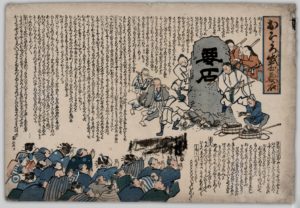
The print in Figure 9 is similar to that found in Figure 5. In it Kashima has just returned from his meeting in Izumo, has suppressed the giant catfish, and his workers are putting the final touches on replacing the kanameishi securely atop the catfish. The crowd consists of people sleeping out in the open for fear of aftershocks. Kashima assures them that the aftershocks will decrease now that he is back in control of the situation and that it is safe to return home. The people explain their earthquake experiences and their hopes for future calm.
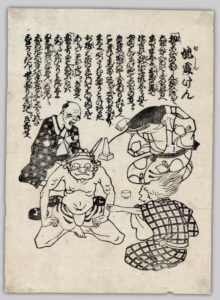
The text in Figure 10 compares the forces of shaking, fire, and rainstorms. The father looking on while drinking sake brings to mind the stereotypical list at that time of the four things everyone fears: earthquakes, thunder, fire, and fathers. The final lines of text make reference to carpenters charging high rates, thus causing “the gradual rectification of society” (dandan yo ga naori 段々世が直り) as they accumulate money.
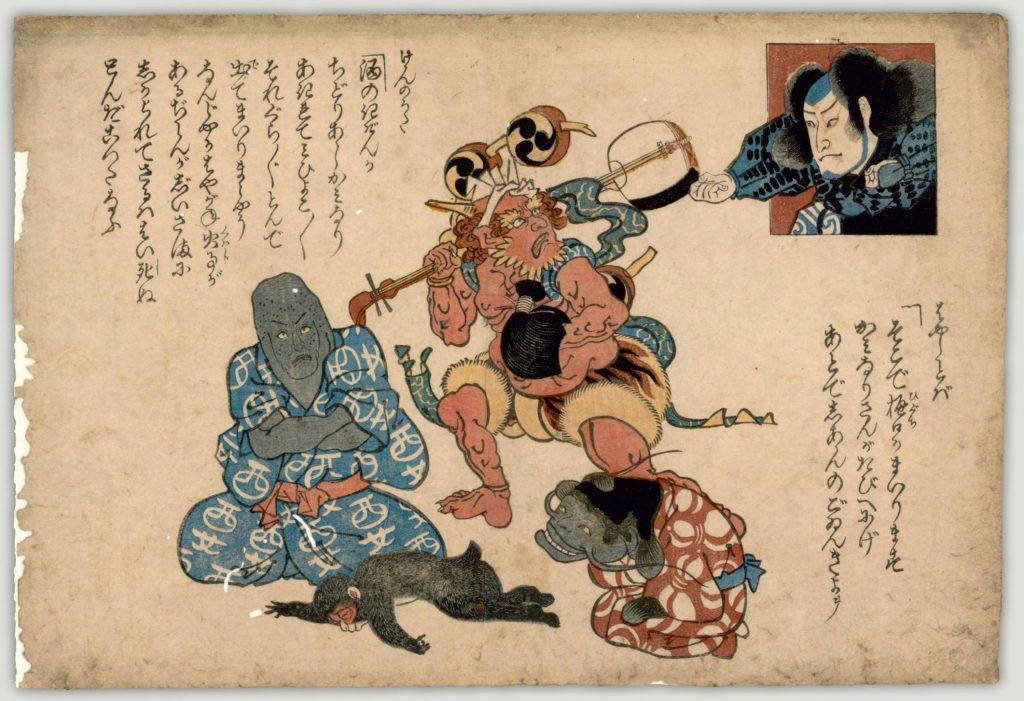
Figure 11 leverages iconography from the genre of popular prints from the Lake Biwa region known as Ōtsue 大津絵. In that genre, a monkey suppresses a catfish with a gourd (typically indicating flood control). Here, the monkey is fast asleep—or perhaps dead. Otherwise, the print bears some similarity to the previous one (number 32, page 18) in that the catfish, the kanameishi-as-stone-warrior, and the actor in the upper right corner are playing a fist game. The thunder deity is trying to escape the scene, apparently with a pilfered courtesan’s shamisen.
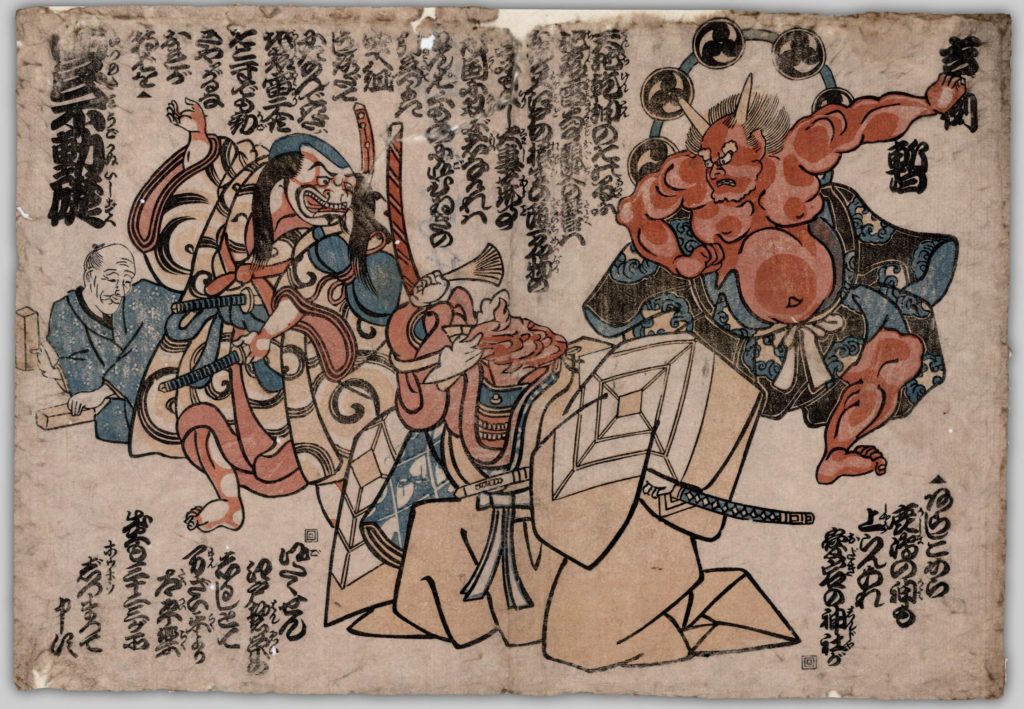
Notice also the father figure in the background of Figure 12, thus creating the earthquakes, fires, thunder, and father set of things that everyone fears, which the text also mentions. Many catfish prints took inspiration from the Kabuki stage, and this one is based on Shibaraku. In the print, fire corresponds to the bombastic hero Kamakura Gongorō Kagemasa, the catfish is the sly Namazu-bōzu (bald-headed, i.e., catfish-headed priest), and thunder appears as “Earthquake thunder” in the parody script. Incidentally, it was common to associate earthquakes and thunder at the time, because earthquakes were generally regarded as the same phenomenon as thunder, but occurring under the ground. Moreover, earthquakes were typically thought to occur along with thunder and lightning.
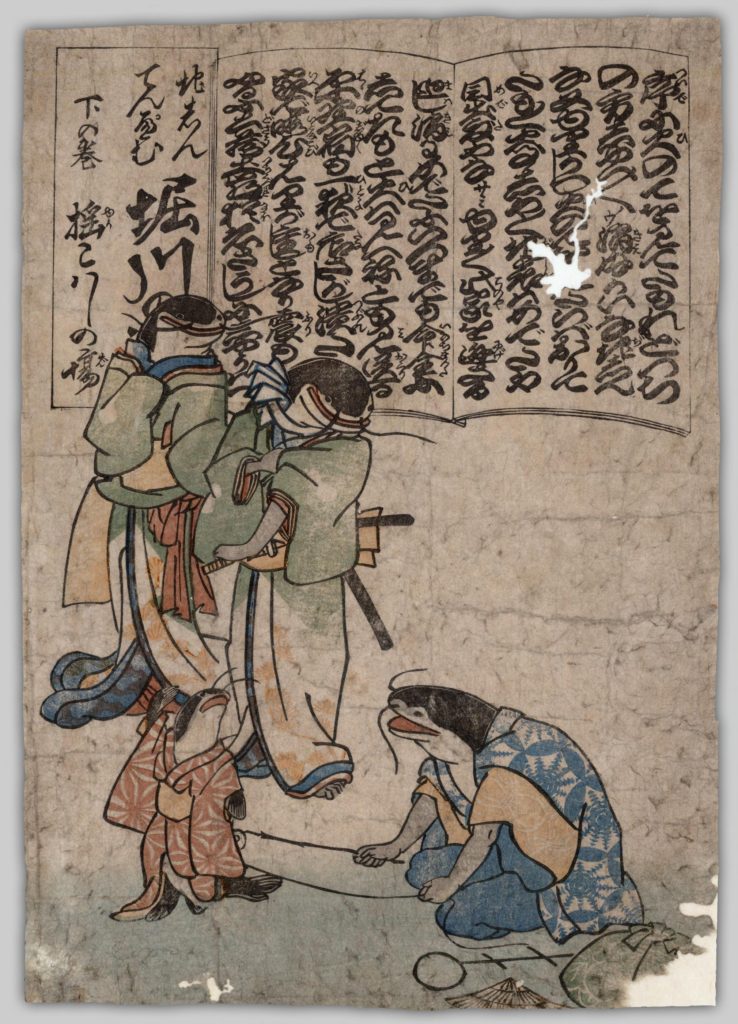
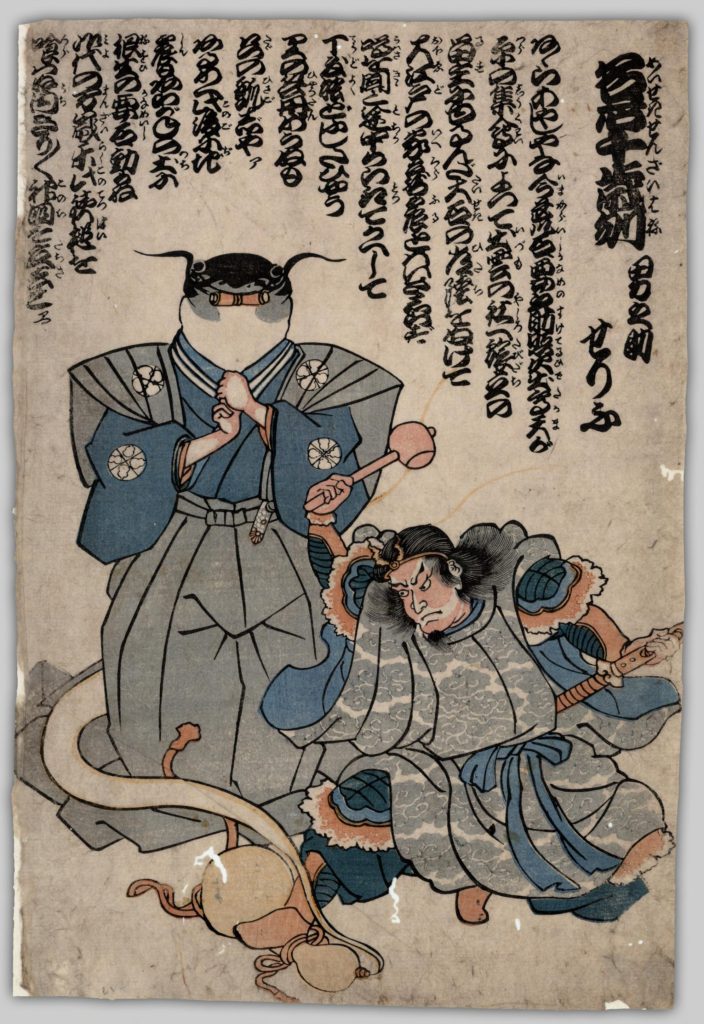
Originally written for the puppet theatre, Gosho Zakura Horikawa youchi 御所桜堀川夜討 was later adopted to the Kabuki stage. In Figure 13 the play has transformed into an earthquake version, with catfish standing in for the Benkei Jōshi scene. The title of the original drama refers to a night attack, and likewise, the Ansei Edo earthquake struck at night.
Figure 14 is based on the Yukashita (below the floor) scene from the Kabuki drama Meiboku sendai hagi 伽羅先代萩. In the original, the scene involves Arajishi Otokunosuke wounding a large rat, which escapes and re-emerges as the arch villain Nikki Danjō. In the print, Arajishi transforms into Araishi Kanamenosuke 荒石要之助, that is, the Kashima deity, and the rat has become a gourd.
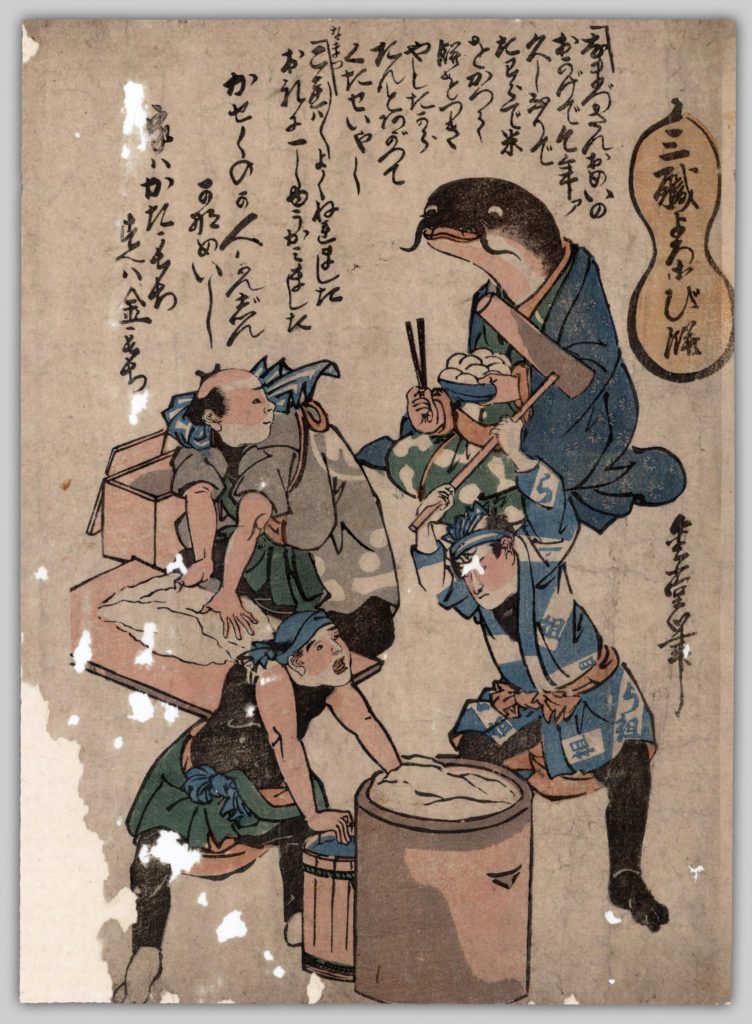
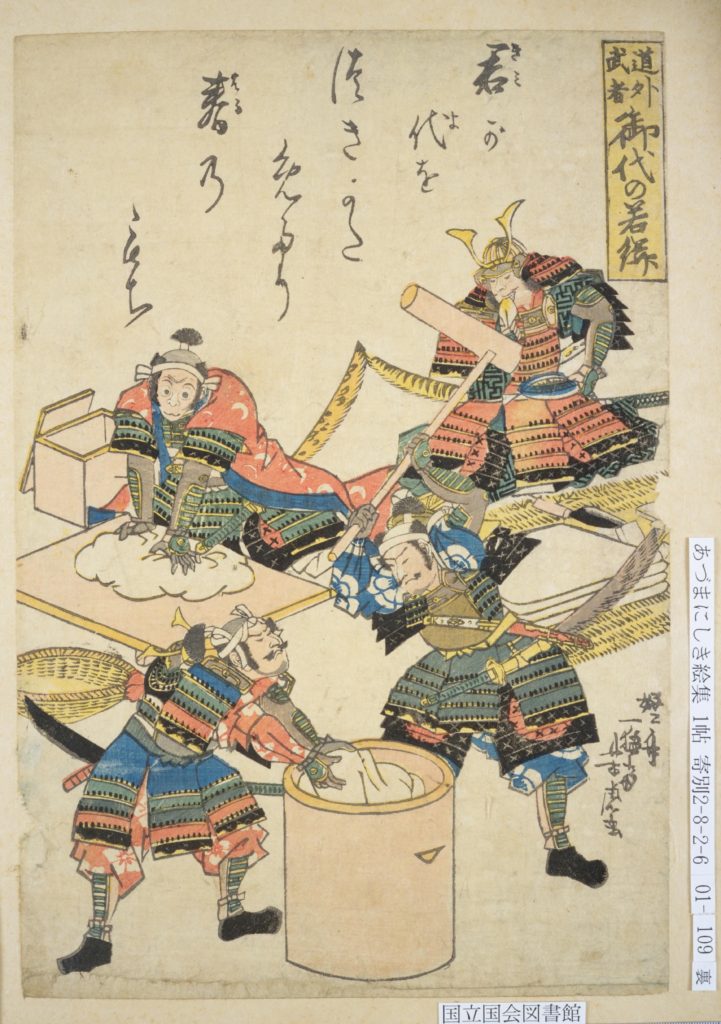
This very interesting print in Figure 15 is much more than the description suggests. First, it shows members of the construction trades preparing mochi (rice cakes) that a catfish is about to eat. In this general way, it indicates the gratitude of the members of the construction trade for the earthquake, which has been so profitable for them.
However, this catfish print is based on an earlier print seen below in Figure 16 that was sufficiently subversive that its maker, Utagawa Yoshitora, was sentenced to a short period of house arrest. The print, made during the 1830s or 40s (the precise date is uncertain) is Dōke musha miyo no wakamochi 道外武者御代の若餅.
The print features Oda Nobunaga and Akechi Mitsuhide pounding the rice into dough, Toyotomi Hideyoshi making the dough into mochi, and Tokugawa Ieyasu relaxing and eating the product of the labor of the others. In other words, the print could be interpreted as belittling Tokugawa Ieyasu’s accomplishment in forging a unified Japan.
Catfish prints are all anonymous, and they were all technically illegal. After approximately two months, the bakufu was able bring sufficient enforcement pressure to bear in shutting down any further production of catfish prints, although by then, many thousand were in circulation. This print is one of several that make clear the mildly subversive potential of some catfish prints. Although ostensibly about the earthquake, many prints commented, often critically or irreverently, on different aspects of society. These prints were able to flourish for so long because the Edo authorities were busy dealing with more pressing problems in the wake of the earthquake.
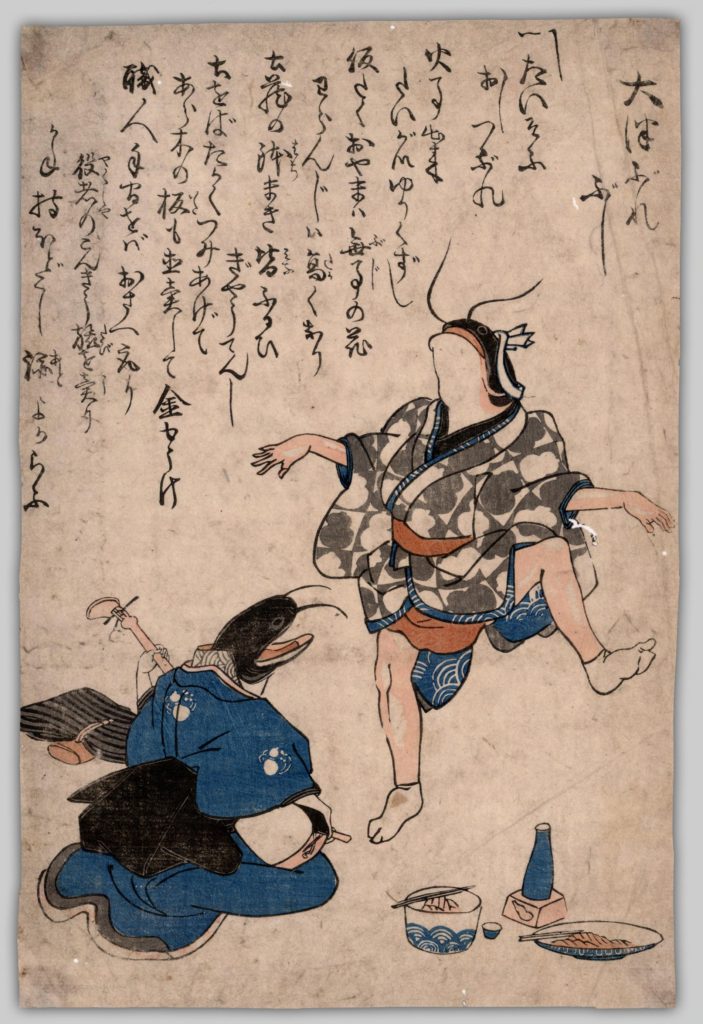
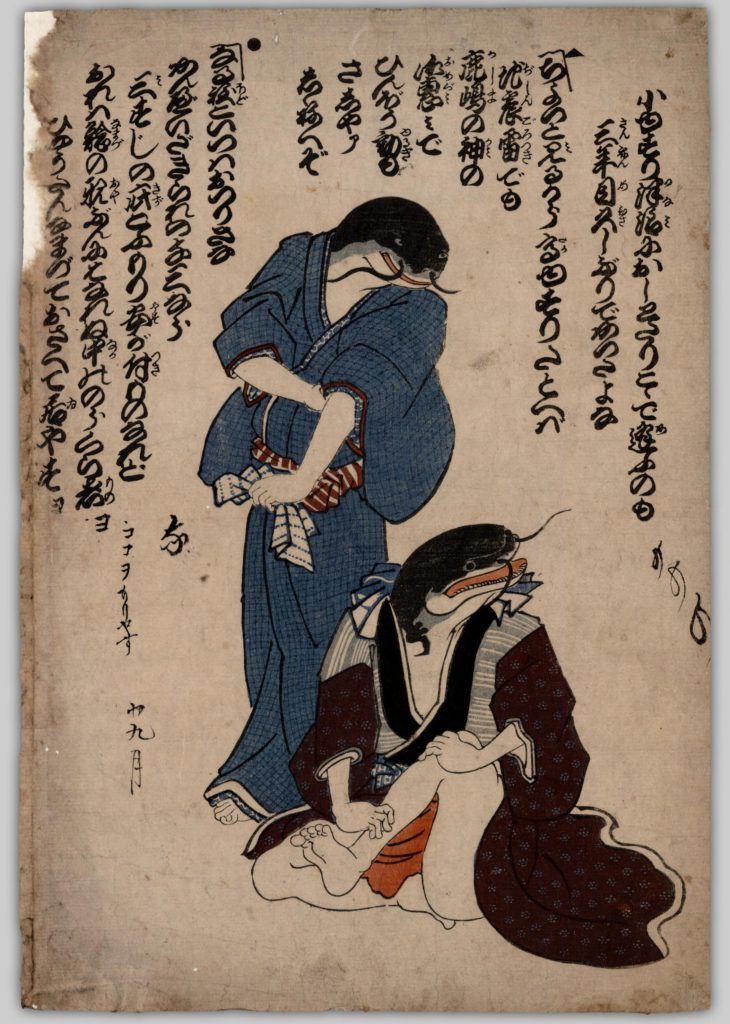
The title of the print in Figure 17 is Ōtsu burebushi 大津ぶれぶし (Ōtsu shaking song), which is a play on the title of the popular song Ōtsue bushi 大津絵節. The text in the print keeps the same phrasing as the song, replacing the original lyrics with descriptions of the earthquake and its aftermath.
Figure 18 is the left page of a two-page print entitled Yomunasake ukiyo arisama 夜無情浮世有様, which is a play on the title of the Kabuki drama Yowanasake ukina no yokogushi 与話情浮名横櫛. The print depicts the Genjidana 源氏店 scene. On the missing (right) page is the Kashima deity, derived from Tazaemon (manager of a successful, large shop) in the original. Yosaburō (a young man living a debauched lifestyle) in the original is the standing catfish in the half of the print depicted here. Kōmori Yasu (Yasu-the-bat), a man with a tattoo of a bat on his cheek, is the seated catfish. This print is yet another example of taking famous Kabuki scenes and refitting them with earthquake-themed text and images.
Further Reading
For a detailed study of the Ansei Edo earthquake, including a detailed discussion of the points in the above paragraphs and a lengthy bibliography of Japanese works, see Gregory Smits, Seismic Japan: The Long History and Continuing Legacy of the Ansei Edo Earthquake (Honolulu: University of Hawaiʻi Press, 2013).
Ruth Ludwin and Gregory Smits, “Folklore and Earthquakes: Native American Oral Traditions from Cascadia Compared with Written Traditions from Japan.” In L. Piccardi and W. B. Masse, eds., Myth and Geology (London: Geological Society of London, 2007): 67-94.
Cornelis Ouwehand, Namazu-e and Their Themes: An Interpretative Approach to Some Aspects of Japanese Folk Religion(Leiden: E. J. Brill, 1964). This study has relatively little to say about the namazue themselves and is instead a thick description of the matrix of folk beliefs in which the namazue were embedded.
Gregory Smits, “Conduits of Power: What the Origins of Japan’s Earthquake Catfish Reveal about Religious Geography,” Japan Review, Vol. 24 (2012): 41-65. This article is in part an update of Ouwehand’s work cited above.
_____, “Namazu-e: Catfish Prints of 1855,” Andon (Publication of the Society for Japanese Arts), Vol. 86 (2009): 35-46.
_____, “Shaking Up Japan: Edo Society and the 1855 Catfish Picture Prints,” Journal of Social History, 39.4 (Summer, 2006): 1045-1077.
_____, “Warding off Calamity in Japan: A Comparison of the 1855 Catfish Prints and the 1862 Measles Prints,” East Asian Science, Technology, and Medicine, No. 30 (2009): 9-31.
The most important reference for catfish prints in Japanese is:
Miyata Noboru 宮田登 and Takada Mamoru 高田衛, eds. Namazue: Shinsai to Nihon bunka 鯰絵:震災と日本文化 (Ribun shuppan, 1995).

